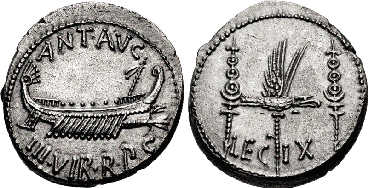|
– The Legionary
Coinage –
–
A Catalogue –
|
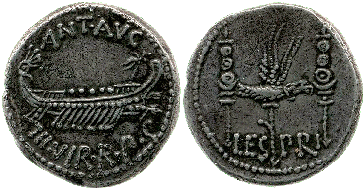
legio prima
This
was a separate unit from Octavian’s legio
I; originally raised by Caesar,
the legion appears to have been disbanded, and its troops
either retired
or merged with Octavian’s legions following the latter's reformation of
the
armies after his victory at Actium. This is the rarest of the
‘legionary’ denarii with only a handful of specimens known to exist.
|

legio II
This
Antonian legion appears to have been disbanded, and its troops either
retired or merged with Octavian’s legions following the latter's
reformation of the
armies after his victory at Actium.
|
 |

legio III
This was probably the legion known as the legio III 'Gallica'
formed by Julius Caesar. It is known to have served in the East under
Antony. An alternative candidate is the legio III
'Cyrenaica' which was possibly raised by Antony himself; its name
indicating its North African origin.
|
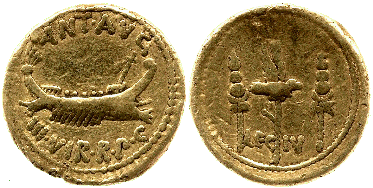
legio IV
This
legion was later called the 'Scythica', but was probably originally
raised by Antony. It was unusual in that it retained its identity even
after Octavian’s reformation of the armies following his victory at
Actium.
|
 |

At least one reverse die shows the
alternative numeration IIII for IV.
|

legio V
'Alaudae'
This
legion was originally raised by Julius Caesar in Transalpine Gaul; its
name, a Gaulish loan-word, meaning the ‘Larks’. Following Caesar’s
death in 44 B.C., it was reconstituted by Antony. It must have been
disbanded, and its troops either retired or merged with Octavian’s
legions following the latter's reformation of the
armies after his victory at Actium.
|

legio VI
'Ferrata'
Originally raised by Julius Caesar in
Cisalpine Gaul in
52 B.C. Following Caesar’s assassination, it was reconstituted by
Marcus Aemilius Lepidus in 44 B.C., and the following year its control
passed to Antony. The legion’s name meant ‘Ironclad’. It must have been
disbanded, and its troops either retired or merged with Octavian’s
legions following the latter's reformation of the
armies after his victory at Actium. |
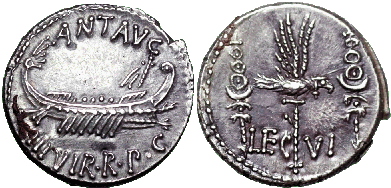 |

legio VII
This Antonian
legion appears to have been disbanded, and its troops either retired or
merged with Octavian’s legions following the latter's reformation of
the
armies after his victory at Actium.
|
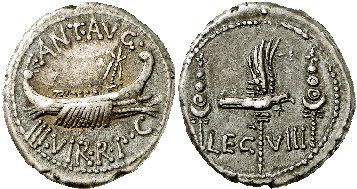
legio VIII
This
Antonian legion appears to have been disbanded, and its troops either
retired or merged with Octavian’s legions following the
latter's reformation of the
armies after his victory at Actium. |

On one obverse die the N of ANT is
retrograde |

One reverse die shows the alternative
numeration IIX for VIII. |

legio IX
This
Antonian legion appears to have been disbanded, and its troops either
retired or merged with Octavian’s legions following the latter's
reformation of the
armies after his victory at Actium. |

At least one reverse die shows the
alternative numeration VIIII for IX. |

legio X
This legion
originated in 59 B.C. or earlier, and, like VI 'Ferrata', it was
reconstituted after the Dictator’s death by Marcus Aemilius Lepidus.
This was in 42 B.C., and the following year it was acquired by Antony
for his campaigns against the Parthians. Following the reformation of
the armies after Octavian’s victory at Actium, Antony’s legio X was merged
with Octavian’s own tenth legion to form the new legio X 'Gemina',
its cognomen ‘Twin’ denoting its dual heritage.
|

legio XI
This
Antonian legion appears to have been disbanded, and its troops either
retired or merged with Octavian’s legions following the latter's
reformation of the
armies after his victory at Actium. |

legio XII
'Antiqua'
Originally raised by Caesar in 58 B.C., legio
XII was reconstituted following the assassination of the Dictator, and
served under Antony on his Eastern campaigns. Following Antony’s defeat
at Actium, the legion seems to have been disbanded, and its troops
either retired or merged with Octavian’s legions. The name ‘Antiqua’ is
otherwise unattested, and the legion appears to have been originally
named 'Fulminata' (Thunderbolt), a name that Octavian's reformed
twelfth continued to bear. The cognomen 'Antiqua' may have had some
purely local significance for the legion within the context of Antony’s
army.
|

Crawford 544/4 records an aureus of
this type at Oxford, but no image is available. |

legio XIII
This
Antonian legion appears to have been disbanded, and its troops either
retired or merged with Octavian’s legions following the
latter's reformation of the
armies after his victory at Actium. |
 |
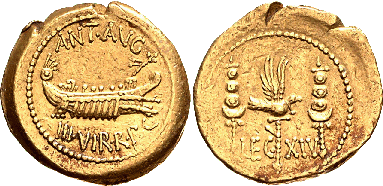
legio XIV
This
Antonian legion appears to have been disbanded, and its troops either
retired or merged with Octavian’s legions following the
latter's reformation of the
armies after his victory at Actium. |
 |

At least one reverse die shows the
alternative numeration XIIII for XIV. |
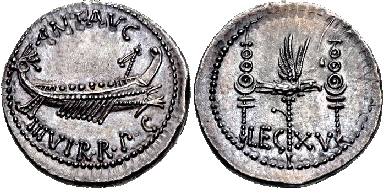
legio XV
This
Antonian legion appears to have been disbanded, and its troops either
retired or merged with Octavian’s legions following the latter's
reformation of the
armies after his victory at Actium. |

legio XVI
This
Antonian legion appears to have been disbanded, and its troops either
retired or merged with Octavian’s legions following the latter's
reformation of the
armies after his victory at Actium. |

legio XVII
'Classica'
This Antonian legion appears to have been disbanded, and its
troops either retired or merged with Octavian’s
legions following the latter's reformation of the
armies after his victory at Actium. The cognomen
'Classica' (Naval) appears to refer to the fact that this legion served
alongside Antony’s navy, perhaps in the capacity of ‘marines’. |
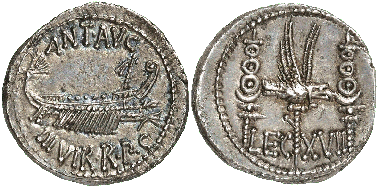 |
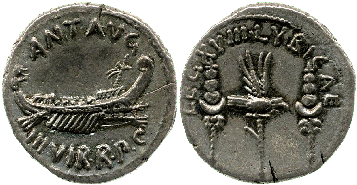
legio XVIII
'Lybica'
This
Antonian legion appears to have been disbanded, and its troops either
retired or merged with Octavian’s legions following the
latter's reformation of the
armies after his victory at Actium. Its cognomen suggests
that it had been raised in North Africa. |

Babelon Antonia
131, citing
Morell, records the
alternative numeration
XIIX for XVIII – confirmation
required. |

legio XIX
This
Antonian legion appears to have been disbanded, and its troops either
retired or merged with Octavian’s legions following the
latter's reformation of the
armies after his victory at Actium. |
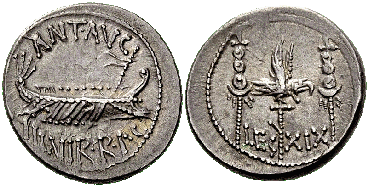 |
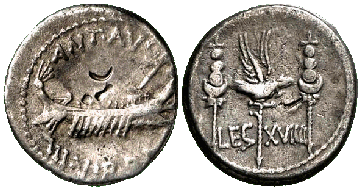
At least one reverse die shows the
alternative numeration XVIIII for XIX. |
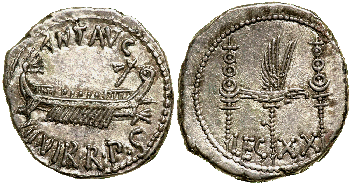
legio XX
A
legion raised by Antony, but after Actium its units were most probably
merged with Octavian’s twentieth, a legion probably only created after
Antony’s defeat. It later became known as legio XX 'Valeria
Victrix'.
|
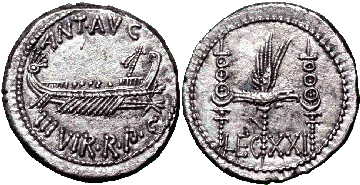
legio XXI
Like
legio
XX, Octavian’s twenty-first legion may have only been formed after the
defeat of Antony at Actium. In which case, it may have
contained elements from Antony’s disbanded XXI.
Calicó 99 records an
aureus of
this type, but no image is available. |
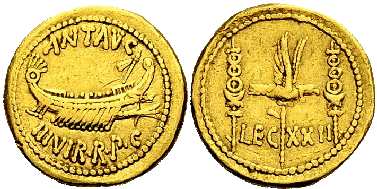
legio XXII
This
Antonian legion appears to have been disbanded, and its troops either
retired or merged with Octavian’s legions following the reformation of
the armies following his victory at Actium. Octavian’s legio XXII
'Deiotariana' was not formed until 25 B.C. when it was formed from
units of the army of King Deiotarus of Galatia which had been trained
on the model of the Roman legions.
|
 |

legio XXIII
This Antonian legion appears to have been disbanded, and its troops
either retired or merged with Octavian’s legions following the
latter's reformation of the
armies after his victory at Actium, and its
number was never used again. In the reformed Army of
Octavian, even though he had twenty-eight legions, the highest number
borne by a legion was twenty-two. This remained the case
until Trajan raised his own legio
XXX 'Ulpia Victrix', which probably
constituted the thirtieth legion in the army establishment as it then
was.
|
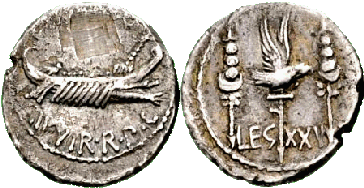
legiones XXIV
– XXX
Denarii
have been described for Antonian legions with these high
numbers. However, it is extremely unlikely that Antony ever
had legions with these numbers (see under legio XXIII).
All
the known specimens are highly suspect, being probably tooled from the
coins of known legions. |
 |
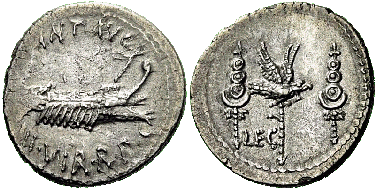
legio ?
This apparently unique coin was struck from a die which had been
prepared, but had not yet had the legion number engraved. The coins
shows no sign of alteration or tooling, and thus supports the theory
that the dies were prepared in advance, and furnished with numerals as
and when needed. |
cohors praetoria
Originally
formed as a small escort for a general they became the elite guards
unit of the Roman army. Their name derived from the commander’s tent (praetorium),
placed at the centre of a legionary marching camp. The same name was
later applied to the commander’s house when the legions moved into
permanent garrison forts. Antony probably had four cohorts of
Praetorians with him at Actium, and their unique nature is shown by
their being honoured alongside, but distinct from, the main legions.
After Antony’s defeat Octavian organised a permanent body of nine
Praetorian cohorts. They were always regard as elite troops, and lived
in better conditions, and received three times the pay of ordinary
legionaries. Three of the cohorts were stationed in Rome and the rest
were distributed through nearby towns. Sejanus under Tiberius allowed
them to build a permanent camp for all the cohorts within the City of
Rome, and this enabled them to have their frequently disastrous effect
on Imperial politics.
|
 |
 |
cohors speculatorum
This unusual issue sheds light on an area of military life which often
went unrecognized. Antony’s cohort of speculatores
were his scouts, messengers, and gatherers of military intelligence,
i.e. spies. Each legion would normally have been allocated ten speculatores,
but Antony formed a separate cohort of them with specific
responsibility to the commander-in-chief. Augustus adopted and
developed this unit, and a mounted speculatorian cohort became central
to the Praetorian Guard, and had the specific task of guarding the
Emperor’s person. The coinage issued for the speculatores varied from
the rest of the legionary coinage in two ways: firstly, three standards
are shown on the reverse and no eagle. This may indicate that this is
not a ‘fighting’ force, but that they were what we would call a support
unit. The second difference is that each of the standards is ornamented
with two wreaths and the prow of a ship. This may reflect some specific
duties that the speculatores
held in regard to the navy, or it may reflect their origins as
‘lookouts’ on board vessels. On Roman ships these lookouts mounted a
turret (specula)
at the stern of the vessel.
|
 |
 |
|
|
